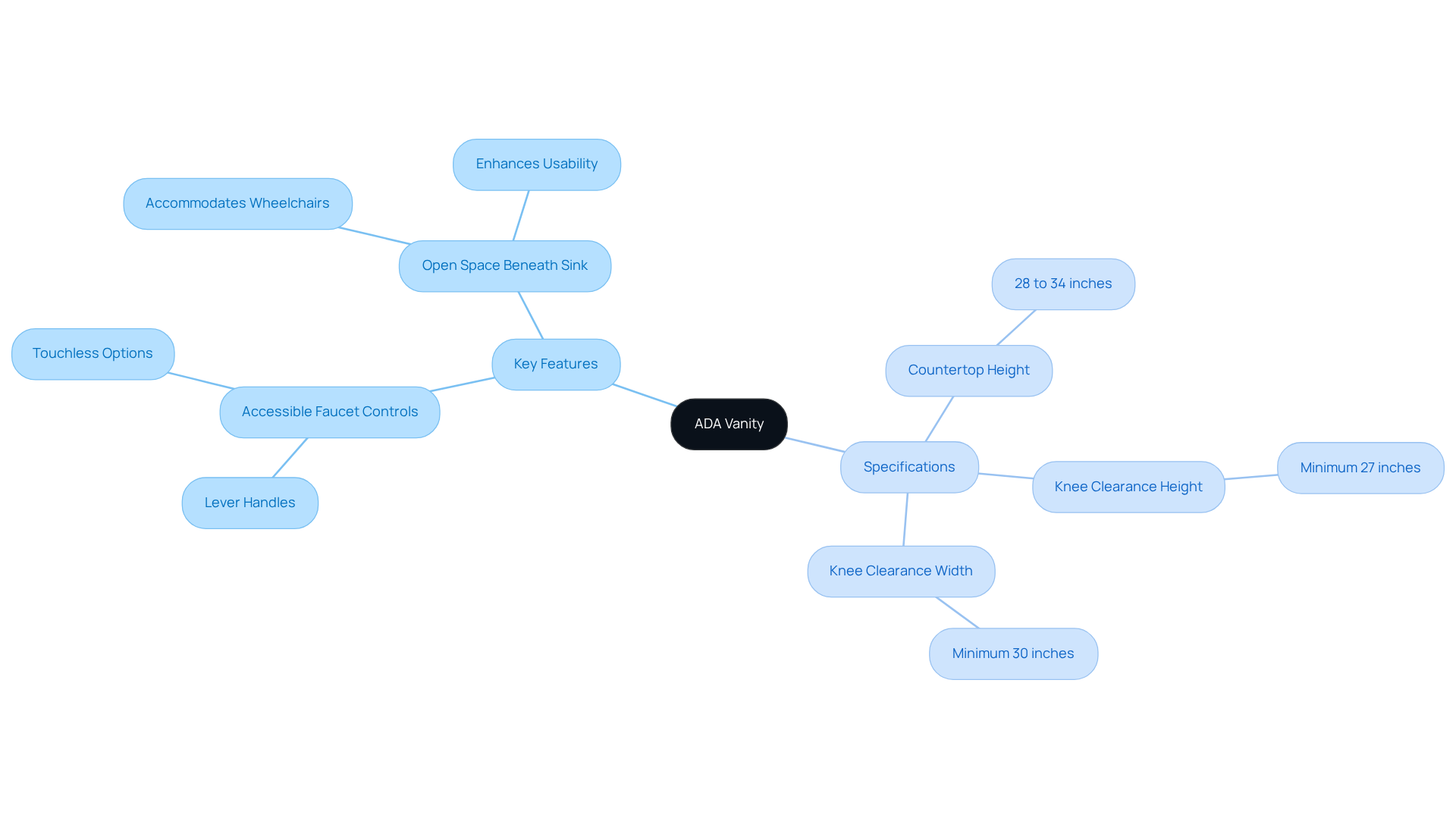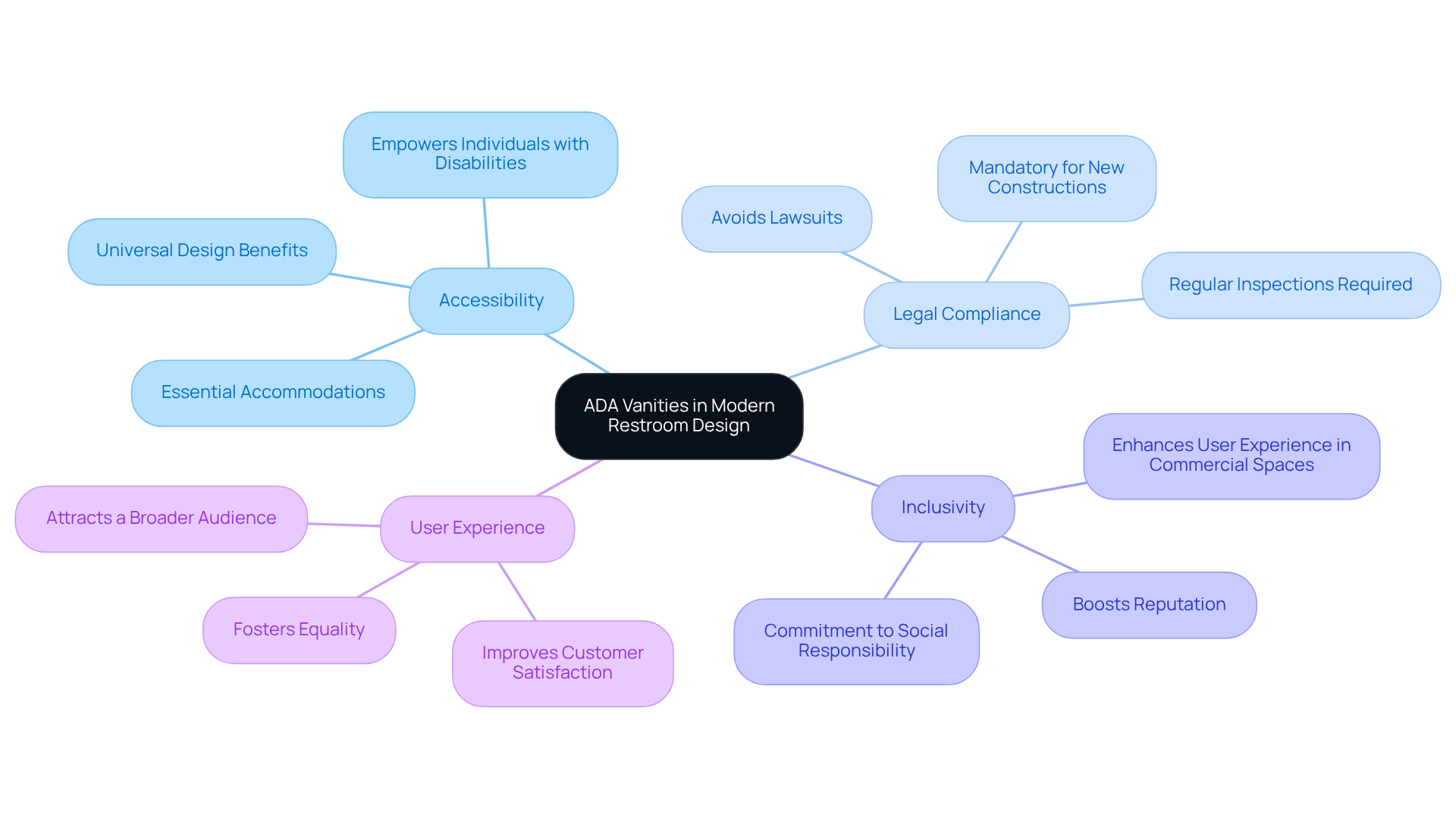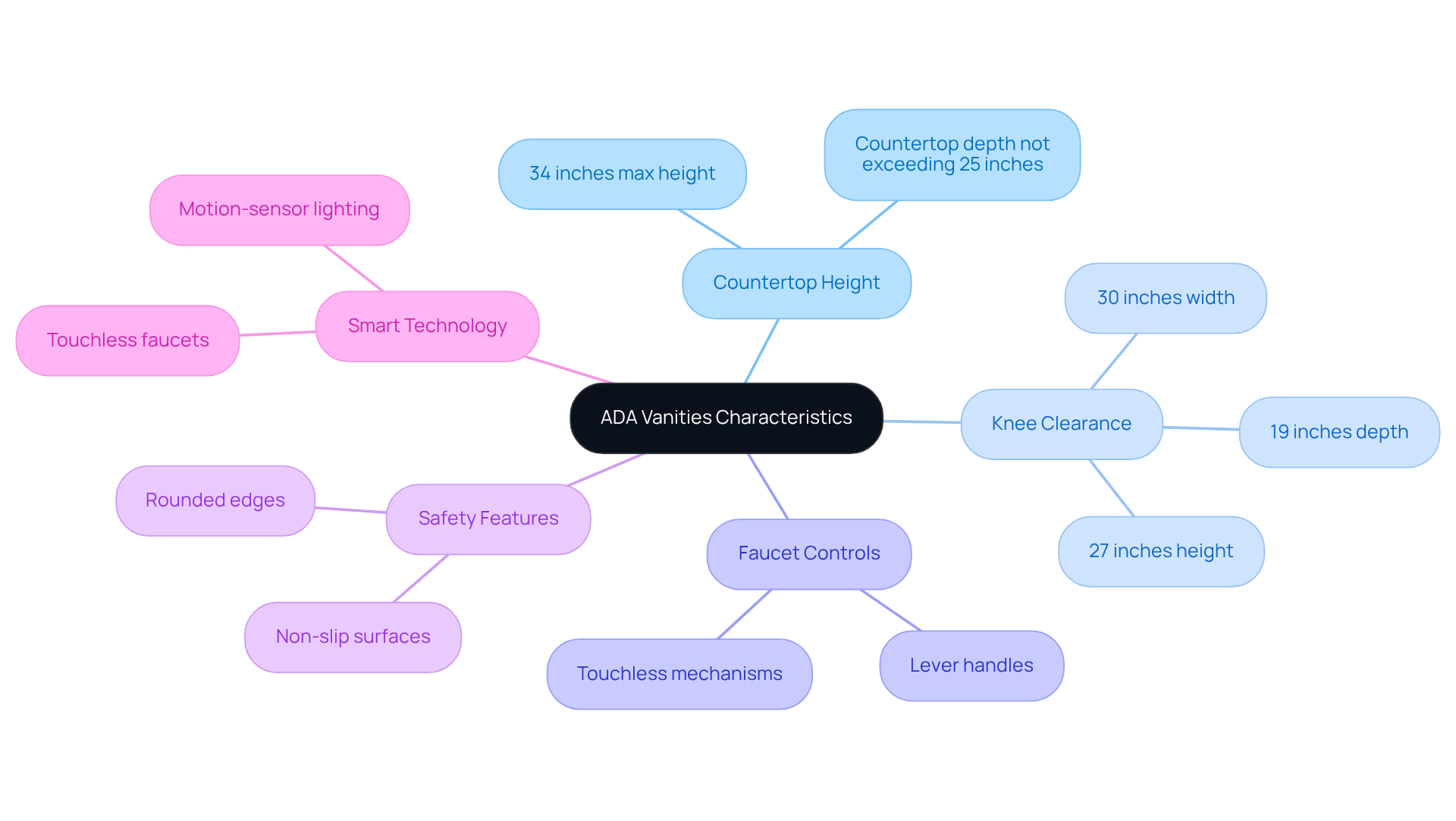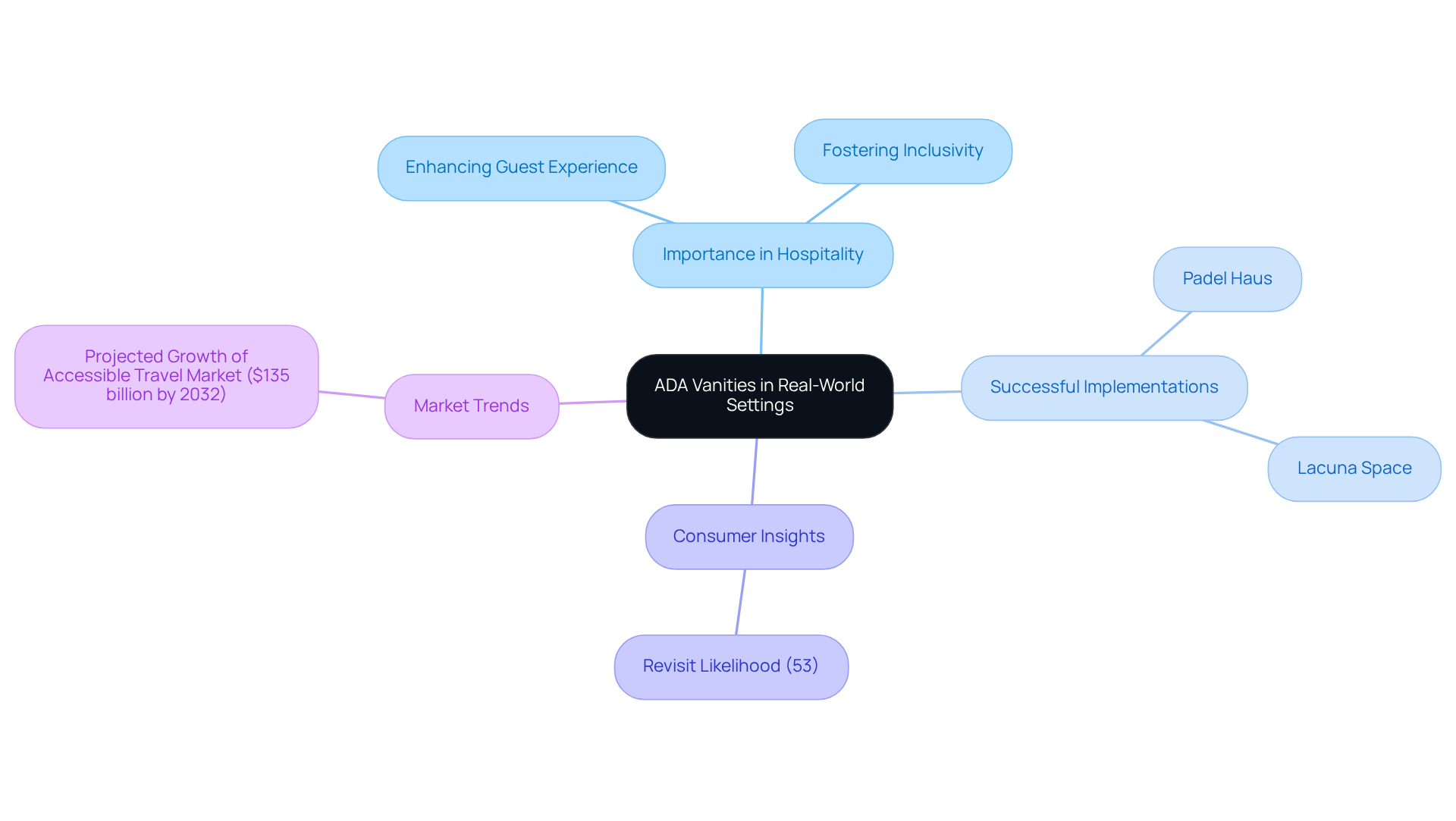Overview
ADA vanities are meticulously crafted to adhere to the accessibility standards established by the Americans with Disabilities Act (ADA). These vanities incorporate:
- Adjustable countertop heights
- Ample knee clearance
- Intuitive faucet controls
These features are specifically designed to accommodate individuals with mobility challenges. The significance of these vanities extends beyond mere compliance; they play a crucial role in fostering inclusive restroom environments that enhance user experience. This is evidenced by successful implementations in commercial settings, such as hotels and restaurants, which not only meet legal requirements but also elevate the overall accessibility and functionality of their facilities.
Introduction
The design of modern restrooms is increasingly shaped by the imperative of inclusivity, rendering ADA-compliant vanities an essential component in the creation of accessible spaces. These meticulously crafted fixtures not only comply with the standards set forth by the Americans with Disabilities Act but also significantly enhance the user experience for individuals facing mobility challenges. As the demand for such accommodations continues to rise, a pivotal question emerges: how can businesses effectively integrate ADA vanities to not only fulfill legal obligations but also cultivate an environment of dignity and respect for all users?
Define ADA Vanity: Key Features and Specifications
An ADA vanity is meticulously engineered to comply with the standards established by the Americans with Disabilities Act (ADA), ensuring accessibility for individuals facing mobility challenges. The design features a countertop height ranging from 28 to 34 inches, facilitating comfortable access for wheelchair users. Furthermore, these fixtures must provide knee clearance of no less than 27 inches in height and 30 inches in width, ensuring ample space for maneuverability.
Accessible faucet controls are essential, often requiring lever handles or touchless options to enhance ease of use. The design may also incorporate an ADA vanity with open space beneath the sink to accommodate wheelchairs, thereby enhancing usability for all individuals.

Contextualize Importance: ADA Vanities in Modern Restroom Design
ADA vanity furnishings are essential in contemporary bathroom design, ensuring that all amenities are accessible to individuals, regardless of their physical capability. The integration of these ADA vanities not only meets legal requirements but also demonstrates a commitment to inclusivity and social responsibility.
As noted by Brent Otsuka, Manager of Interior Design at Fentress Architects:
- The Splash Lab offers well-crafted and aesthetically pleasing products, making them a preferred choice for creating holistically designed washrooms.
- In commercial environments such as hotels, restaurants, and public buildings, restrooms featuring ADA vanity significantly enhance user experience and uphold the dignity of individuals with disabilities.
- Furthermore, companies that prioritize inclusivity can bolster their reputation and customer satisfaction, showcasing their dedication to serving all community members.
The presence of ADA fixtures is a critical step toward creating equitable spaces that cater to diverse needs.

Trace the Evolution: History of ADA Standards and Vanities
The Americans with Disabilities Act (ADA), enacted in 1990, marked a pivotal moment in advancing disability rights across the United States. This significant legislation sought to remove obstacles to accessibility in public areas, including facilities. Since its inception, the ADA has evolved, with the 2010 Standards for Accessible Design presenting extensive guidelines that specifically focus on bathroom fixtures and other sanitation components. This evolution underscores a heightened awareness of the necessity for inclusive design.
Historically, sanitary facilities frequently overlooked the needs of individuals with disabilities. However, the introduction of ada vanity, along with faucets, soap dispensers, and other restroom fixtures from The Splash Lab, has significantly reshaped this environment, ensuring that all users can access and utilize restroom facilities with dignity and ease. For instance, the 2010 Standards allow for greater flexibility in the placement of wheelchair-accessible toilets, now permitting the centerline to be positioned between 17 and 19 inches from the wall, compared to the previous requirement of 18 inches. This adjustment demonstrates a broader commitment to improving ease of access.
Statistics reveal the impact of these changes: approximately 1.5 billion people worldwide live with disabilities, representing a substantial market that collectively spends around half a trillion dollars annually. Furthermore, the Department of Justice has intensified enforcement of ADA provisions, highlighting the urgency for compliance among businesses. As Thomas Paul Rebel emphasizes, 'The moment to take action is now,' encouraging retailers and designers to prioritize inclusivity in their projects.
Case studies, such as the renovations at Lacuna Space in California and Padel Haus in New York, illustrate the successful implementation of ADA-compliant restroom solutions. These projects not only improved functionality but also emphasized aesthetic appeal, demonstrating that usability and design can coexist harmoniously. The development of ADA standards and the launch of ADA vanity fixtures, faucets, and accessories from The Splash Lab represent an important advancement in establishing inclusive spaces that address the varied requirements of all individuals.

Identify Key Characteristics: Distinctions of ADA Vanities
ADA-compliant furnishings are defined by essential features that prioritize accessibility and comfort for individuals. The maximum countertop height is set at 34 inches, facilitating easy access for those in wheelchairs. To enhance usability, these vanities must offer knee clearance of at least 27 inches in height and 30 inches in width, allowing users to approach the sink with ease. Faucet controls are designed for simplicity, often incorporating lever handles or touchless mechanisms, which are especially advantageous for individuals with limited dexterity. Safety features, including rounded edges and non-slip surfaces, are crucial to the design, fostering a secure and user-friendly bathroom environment. These elements not only comply with ADA standards but also enhance the overall restroom experience with ADA vanity features.
As David Nguyen, a content writer, notes, "Selecting ADA-compliant furnishings is a vital choice for guaranteeing accessibility, adhering to legal requirements, and improving user experience in both commercial and residential environments."
Furthermore, the growing trend of integrating smart technology into these furnishings, such as touchless faucets, is transforming them into more user-friendly fixtures. Customization options for furnishings, such as ADA vanity, provide tailored solutions that address both residential and commercial needs, ensuring compliance with regulations while fitting the aesthetic and functional requirements of diverse environments. This thoughtful design approach is exemplified in successful projects like Padel Haus and Lacuna Space, where the integration of these features significantly enhanced accessibility and user satisfaction.

Explore Practical Applications: ADA Vanities in Real-World Settings
ADA-compliant furnishings are essential in numerous commercial settings, particularly within the hospitality industry. Hotels that incorporate these features not only fulfill legal requirements but also significantly enhance the guest experience. Notable examples include Padel Haus in New York and Lacuna Space in California, both of which have successfully implemented ADA vanity solutions. These installations create inclusive spaces that cater to all guests, illustrating how thoughtful design decisions—such as material selection and spatial arrangement—directly enhance usability and user comfort.
By integrating ADA-compliant features, businesses foster a welcoming atmosphere that acknowledges and respects the diverse needs of all individuals. Statistics reveal that 53% of consumers would not revisit a venue where entry was challenging, underscoring the importance of accessibility in promoting positive guest experiences. Furthermore, with the global accessible travel market projected to reach $135 billion by 2032, investing in ADA-compliant solutions positions establishments to attract a growing demographic of travelers who prioritize accessibility.

Conclusion
ADA vanities transcend their role as mere fixtures; they embody a profound commitment to accessibility and inclusivity within restroom design. By adhering to the standards established by the Americans with Disabilities Act, these vanities guarantee that individuals with mobility challenges can access and utilize bathroom facilities with dignity and ease. Thoughtful design elements—such as appropriate countertop heights, knee clearance, and user-friendly faucet controls—are essential in fostering an environment where everyone feels welcome.
The key arguments presented throughout this article underscore the vital role of ADA vanities in contemporary restroom design. These fixtures not only meet legal obligations but also enhance user experiences across various settings, including hotels and public buildings. The evolution of ADA standards since their inception in 1990 has led to significant advancements in accessibility, highlighting the necessity for inclusive design that addresses the diverse needs of all individuals. Real-world applications, exemplified by successful projects like Padel Haus and Lacuna Space, showcase how ADA-compliant solutions can seamlessly blend functionality with aesthetic appeal.
The importance of ADA vanities extends beyond mere compliance; it signifies a broader societal commitment to inclusivity. As the demand for accessible spaces continues to rise, embracing ADA-compliant design becomes not just a legal requirement but a moral imperative. Organizations and businesses are urged to prioritize these solutions, cultivating environments that respect and celebrate diversity. By investing in ADA vanities, the community can ensure that everyone, regardless of their physical capabilities, has the opportunity to navigate public spaces comfortably and confidently.
Frequently Asked Questions
What is an ADA vanity?
An ADA vanity is designed to comply with the Americans with Disabilities Act (ADA) standards, ensuring accessibility for individuals with mobility challenges.
What are the key features of an ADA vanity?
Key features include a countertop height ranging from 28 to 34 inches, knee clearance of at least 27 inches in height and 30 inches in width, accessible faucet controls (such as lever handles or touchless options), and open space beneath the sink to accommodate wheelchairs.
Why are ADA vanities important in modern restroom design?
ADA vanities are essential in contemporary bathroom design as they ensure that all amenities are accessible to individuals regardless of their physical capabilities, meeting legal requirements and demonstrating a commitment to inclusivity and social responsibility.
How do ADA vanities enhance user experience in commercial environments?
In commercial environments like hotels, restaurants, and public buildings, ADA vanities significantly enhance user experience by upholding the dignity of individuals with disabilities and promoting a more inclusive atmosphere.
What impact do ADA vanities have on a company's reputation?
Companies that prioritize inclusivity by incorporating ADA vanities can bolster their reputation and customer satisfaction, showcasing their dedication to serving all community members and creating equitable spaces.




